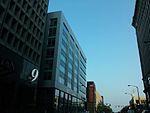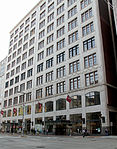Swetland Building (Cleveland)

The Swetland Building, also known as 1010 Euclid Avenue, is a 175 foot (53 m), 13-story historic high-rise building in the Nine-Twelve District of downtown Cleveland built in 1910. It is located at the intersection of Euclid and East 9th Street near other historic buildings such as the Cleveland Athletic Club, Huntington Bank Building, and Statler Arms Apartments. The Swetland is of the Chicago school of architecture and has many intricate details at its base and summit, typical of the Chicago style. Architect Alexander C. Wolf of East Cleveland had his offices in the structure and later served as a member of the Cleveland Planning Commission. Also present in the building was fine jeweler Rickey C. Tanno who started his company in 1929 in the Swetland and remained there until 1949, when he moved across the street into the Union Commerce Bank Building.
Excerpt from the Wikipedia article Swetland Building (Cleveland) (License: CC BY-SA 3.0, Authors, Images).Swetland Building (Cleveland)
Euclid Avenue, Cleveland
Geographical coordinates (GPS) Address External links Nearby Places Show on map
Geographical coordinates (GPS)
| Latitude | Longitude |
|---|---|
| N 41.500083333333 ° | E -81.68575 ° |
Address
1010 Euclid
Euclid Avenue 1010
44115 Cleveland
Ohio, United States
Open on Google Maps











